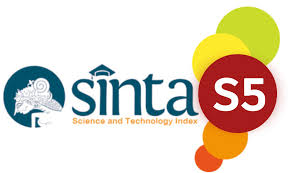Potensi Rumput Laut Sebagai Sumber Serat Pangan Alami: Tinjauan Literatur
Keywords:
Potential, Seaweed, Source of Food and Natural FiberAbstract
WHO research data for 2023 shows that as many as 95% of the population in Indonesia aged 10 years and over experience insufficient consumption of vegetables and fruit. Low fiber consumption is the main reason people don't like vegetables. The average fiber intake of the Indonesian population is only around 7 grams per day, while the recommended fiber consumption is 10 grams per day for adults and 20 grams per day for teenagers. This research was carried out by reviewing relevant literature sources to answer the objectives in accordance with published research results. The purpose of this paper is to determine the fiber content, nutrients and health benefits of consuming seaweed and the application of seaweed in various food preparations. Literature source searches were carried out using electronic databases such as Google Scholar, Science Direct, and Re-searchgate. Literature that meets the requirements is then analyzed using descriptive methods. The findings of this research are that seaweed has nutritional content that varies depending on the type and species, seaweed also contains important minerals such as calcium, phosphorus, sodium and potassium. Calcium is needed for good bone and tooth health, while potassium plays a role in maintaining healthy body fluid balance and blood pressure. Seaweed also contains bioactive compounds such as beta carotene and vitamin C. Seaweed is also used as a thickener or stabilizer in the food industry. and drinks.
References
Abas, A. (2006). Minuman Fungsional Berbahan Dasar Teh dan Kayu Manis Untuk Penderita Diabetes. Prosiding Seminar Nasional Iptek. Hal 91-98.
Alloyarova, Y. V., Kolotova, D. S., & Derkach, S. D. (2024). Nutritional and therapeutic potential of functional components of brown seaweed: A review. Foods and Raw Materials 12(2).
Anggadiredja J. T. 2011. Laporan Forum Rumput Laut. Pusat Riset Pengolahan Produk dan Sosial Ekonomi Kelautan dan Perikanan. Jakarta.
Anggadiredja, J.T., Zatnika, A., Purwoto, H., & Istini, S., (2006). Rumput Laut. Jakarta (ID): Penebar Swadaya.
Anggraeni, F. N., Suryaningsih, L., & Putranto, W. S. (2020). Pengaruh Penambahan Rumput Laut (Eucheuma Cottonii) Pada Pembuatan Bakso Puyuh Terhadap Sifat Fisik Dan Akseptabilitas. Jurnal Teknologi Hasil Peternakan, 1(2):55-66.
Astawan, M. 2007. Nugget Ayam Bukan Makanan Sampah. PT. Gramedia Pusaka Utama. Jakarta.
Astawan, M., Koswara, S., & Herdiani, F. (2014). Pemanfaatan rumput laut (Eucheuma cottonii) untuk meningkatkan kadar iodium dan serat pangan pada selai dan dodol. Jurnal Teknologi dan Industri Pangan, 15(1): 61-69.
Ate, J.N.B., & da Costa, J.F. (2017). Analisis kandungan nutrisi Gracilaria edule (SG Gmelin) PC Silva dan Gracilaria coronopifolia J. Agardh untuk pengembangan perekonomian masyarakat pesisir. Jurnal Ilmu Kesehatan, 5(2), 94-103.
Badan Standarisasi Nasional. (2014). Bakso Daging. SNI 01-3818-2014 Jakarta.
Baghel, R. S., Choudhary, B., Pandey, S., Pathak, P. K., Patel, M. K., & Mishra, A. (2023). Rehashing Our Insight of Seaweeds as a Potential Source of Foods, Nutraceuticals, and Pharmaceuticals. Foods 12(19)
Billina, A., Waluyo, S., & Suhandy, D. (2014). Kajian Sifat Fisik Mie Basah Dengan Penambahan Rumput Laut. Jurnal Teknik Pertanian Lampung. 4(2): 109-116
Cheng, Y. F., & Bhat, R. (2016). Functional, physicochemical and sensory properties of novel cookies produced by utilizing underutilized jering (Pithecellobium jiringa Jack.) legume flour. Food Bioscience, 14, 54-61.
Erniati., Zakaria, F. R., Prangdimurti, E., & Adawiyah, D. R. (2016). Potensi rumput laut: Kajian komponen bioaktif dan pemanfaatannya sebagai pangan fungsional. Acta Aquatica 3(1): 12-17.
Gomez-Zavaglia, A., Prieto Lage, M. A., Jimenez-Lopez, C., Mejuto, J. C., & Simal-Gandara, J. (2019). The potential of seaweeds as a source of functional ingredients of prebiotic and antioxidant value. Antioxidants, 8(9).
Handayani, R. & Aminah, S. (2015). Variasi substitusi rumput laut terhadap kadar serat dan mutu organoleptik cake rumput laut (Eucheuma cottonii). Jurnal Pangan dan Gizi, 2(3): 67-74.
Hanifah, Nur Islami Dini, dan Fillah Fithra Dieny. 2016. Hubungan Total Asupan Serat Larut Air (Soluble), dan Serat Tidak Larut Air (Insoluble) dengan Kejadian Sindrom Metabolik pada Remaja Obesitas. Ilmu Gizi Fakultas Kedokteran Universitas Diponegoro : Semarang.
Harborne, 2000. Metode Fitokimia, Penuntun Cara Modern Menganalisis Tumbuhan, ITB, Bandung.
Jan, R., Saxena, D. C., & Singh, S. (2016). Physico chemical, textural, sensory and antioxidant characteristics of gluten Free cookies made from raw and germinated Chenopodium (Chenopodium album) flour. LWT-Food Science and Technology, 71, 281-287.
Jane, L. V. N. (2015). Pengaruh Subtitusi Daging Ikan Madidihang Dengan Rumput Laut Kappaphycus alvarezii Terhadap Komposisi Gizi Bakso Ikan Madidihang. Jurnal Ilmiah agribisnis dan Perikanan (agrikan UMMU-Ternate). 8(2):Oktober.
Jehn, F. U., Dingal, F. J., Mill, A., Harrison, C., Ilin, E., Roleda, M. Y., James, S. C., & Denkenberger, D. (2024). Seaweed as a Resilient Food Solution After a Nuclear War. Earth's Future 12(1).
Justicia, A., Liviawaty, E. & Hamdani, H. (2012). Fortifikasi tepung tulang nila merah sebagai sumber kalsium terhadap Tingkat kesukaan roti tawar. Jurnal Perikanan dan Kelautan, 3(4): 17- 27.
Kadi, A. (2014). Rumput laut sebagai produk alam dari Perairan Indonesia. Oseana, 39(3), 31-40.
Kemenkes, R.I, (2014). Situasi dan Analisis Diabetes. Pusat Data dan Informasi Kemetrian Kesehatan. Jakarta (ID). Kementrian Kesehatan RI.
Khomsan, A. (2004). Pengantar Pangan dan Gizi untuk Kesehatan. PT Raja Grafindo Persada, Jakarta.
Koutsaviti, A., Ioannou, E., & Roussis, V. (2018). Bioactive Seaweed Substances. In Bioactive Seaweeds for Food Applications. Elsevier Inc. https://doi.org/10.1016/B978-0-12-813312-5.00002-9
Kumar, Y., Tarafdar, A., & Badgujar, P. C. (2021). Seaweed as a Source of Natural Antioxidants: Therapeutic Activity and Food Applications. Back to Nature: Natural Antioxidants in Food
Lalopua, V.M.N. (2017). Pemanfaatan dan karakteristik nori tiruan menggunakan bahan baku alga Hypnea saidana dan Ulva conglubata dari perairan Maluku. Majalah Biam, 13(02), 33-40.
Leandro, A., D. Pacheco, J. Cotas, J.C. Marques, L. Pereira, & A.M.M. Gonçalves. 2020. Seaweed’s bioactive candidate compounds to food industry and global food security. Life, 10(140): 1–37.
Litaay, C., Arfah, H., & Pattipeilohy, F. (2022). Potensi Sumber Daya Hayati Rumput Laut di Pantai Pulau Ambon sebagai Bahan Makanan. Jurnal Pengolahan Hasil Perikanan Indonesia, 25(3), 405-417. http://dx.doi.org/10.17844/jphpi.v25i3.41647
Lu, L. W., & Chen, J. H. 2022. Seaweeds as Ingredients to Lower Glycemic Potency of Cereal Foods Synergistically—A Perspective. Foods 11(5)
Lubis, Y. M., Erfiza, N. M., Ismaturrahmi., & Fahrizal. (2013). Pengaruh Konsentrasi Rumput Laut (Eucheuma Cottonii) dan Jenis Tepung pada Pembuatan Mie Basah . Rona Teknik Pertanian, 6(1) : 413 – 720.
Maharany F, Nurjanah, Suwandi R, Anwar E, Hidayat T. 2017. Kandungan senyawa bioaktif rumput laut Padina australis dan Euchema cottonii sebagai bahan baku krim tabir surya. Jurnal Pengolahan Hasil Perikanan Indonesia. 20(1): 10-17
Malyarenko, O. S., & Ermakova, S. P. (2017). Fucoidans: Anticancer Activity and Molecular Mechanisms of Action. In Seaweed Polysaccharides: Isolation, Biological and Biomedical Applications. Elsevier Inc.
Manteu SH, Nurjanah, Nurhayati T. 2018. Karakteristik rumput laut cokelat (Sargassum policystum dan Padina minor) dari perairan Pohuwato Provinsi Gorontalo. Jurnal Pengolahan Hasil Perikanan Indonesia. 21(3): 396-405.
Nina, A. (2004). Pengaruh Konsumsi Serat dan Antioksidan (Vitamin A, C dan E) terhadap Kejadian Penyakit Jantung Koroner (Studi Pasien Rawat Jalan di BPRSUD Salatiga). Skripsi. Semarang: Universitas Diponegoro.
Ningsih, D., Wijanarko, A. 2018. Peran Protein dalam Kehidupan Organisme Perairan. Jurnal Biologi Tropika, 18(2): 154-160.
Nuñez, M., & Picon, A. (2017). Seaweeds in yogurt and quark supplementation: influence of five dehydrated edible seaweeds on sensory characteristics. International Journal of Food Science and Technology, 52(2), 431–438. https://doi.org/10.1111/ijfs.13298
Nurtama, B., & Sulistyani Y. (1997). Buletin Teknologi dan Industri Pangan : Suplementasi Ikan Pada Makanan Ringan Produk Ekstrusi dengan Bahan Dasar Beras. Jurusan Teknologi Pangan dan Gizi Institut Pertanian Bogor. Bogor.
Oh, H., Lee, P., Kim, S. Y., & Kim, Y. S. (2020). Preparation of cookies with various native seaweeds found on the Korean coast. Journal of Aquatic Food Product Technology, 29(2), 167-174.
Pamungkas, P., Yuwono, S.S, & Fibrianto, K. (2019). Potensi rumput laut merah (Gracilaria gigas) dan penambahan daun kenikir (Cosmos caudatus) sebagai bahan baku pembuatan nori. Jurnal Teknologi Pertanian, 20(3), 171-80.
Peñalver, R., Lorenzo, J. M., Ros, G., Amarowicz, R., Pateiro, M., & Nieto, G. (2020). Seaweeds as a Functional Ingredient for a Healthy Diet. Mar Drugs 18(6).
Premarathna, A. D., Tuvikene, R., Fernando, P. H. P., Adhikari, R., Perera, M. C. N., Ranahewa, T. H., Howlader, M. M., Wangchuk, P., Jayasooriya, A. P., & Rajapakse, R. P. V. J. (2022). Comparative analysis of proximate compositions, mineral and functional chemical groups of 15 different seaweed species. Scientific Reports, 12(1), 19610. https://doi.org/10.1038/s41598-022-23609-8
Prita, A. W., Mangkurat, R. S. B., & Mardika A. (2021). Potensi Rumput Laut Indonesia Sebagai Sumber Serat Pangan Alami: Telaah Pustaka
Qin, Y. 2018. Applications of Bioactive Seaweed Substances in Functional Food Products. In Bioactive Seaweeds for Food Applications. Elsevier Inc.
Rahayu, A. P. (2018). Pemanfaatan Rumput Laut (Eucheuma Cottonii) Menjadi Roti Tinggi Serat Dan Yodium. ARGIPA 3(1): 26-36.
Rehena, Z., & Ivak, L.M., (2019). Pengaruh substitusi Rumput Laut terhadap kandungan serat Cookies Sagu. Jurnal Agribisnis Perikanan, Vol.12(1): 157-161.
Riset Kesehatan Dasar. (2013). Laporan Hasil Riset Kesehatan Dasar. Jakarta: Badan Penelitian dan Pengembangan Kesehatan Kementerian Kesehatan Republik Indonesia.
Rusilanti., Clara, M., & Kushanto. 2007. Sehat dengan Makanan Berserat. Agro Media Pustaka :Jakarta.
Rustandi, D. (2011). Powerful UKM: Produksi Mie. PT Tiga Serangkai Pustaka Mandiri. Solo. 124 Hal.
Sanchez-Machado DJ, Lopez-Cervantes, LopezHernandez J, Paseiro-Losada P. 2014. Fatty Acids, Total Lipid, Protein and Ash Content of Processed Edible Seaweeds. Food Chemistry. (85):439-444.
Sandrasari, D. A., Chusna, A. C. (2020). Karakteristik Crispy Cookies Kaya Serat Berbahan Dasar Rumput Laut. Jurnal Teknologi Pangan, 2(2): 105-114.
Silaban, R. (2019). Komunitas makro alga di Perairan Pantai Desa Wakal, Kabupaten Maluku Tengah. Jurnal Sumberdaya Akuatik Indopasifik, 3(1), 45-56
Srimariana, E.S., Kawaroe, M., Lestari, D.F., Nugraha, A.H. (2020). Keanekaragaman dan potensi pemanfaatan makroalga di pesisir Pulau Tunda. Jurnal Ilmu Pertanian Indonesia, 25(1), 138-144.
Sulistyowati, H. 2003. Struktur komunitas Seaweed(rumput laut) di Pantai Pasir Putih Kabupaten Situbondo. Jurnal Ilmu Dasar. 4 (1): 58-61.
Triana, A., & Maita, L. (2019). Pemanfaatan Tepung Ampas Kelapa Sebagai Bahan Baku Pembuatan Kue Serat Tinggi Untuk Pencegahan Konstipansi Pada Ibu Hamil. Gemassika 3(1): 19-26.
Waluyo, W., Permadi, A., Fanni, N.A., & Soedrijanto, A. (2019). Analisis kualitas rumput laut Gracilaria verrucosa di tambak Kabupaten Karawang, Jawa Barat. Grouper: Jurnal Ilmiah Fakultas Perikanan Universitas Islam Lamongan, 10(1), 32-41.
Wirjatmadi, B., M. Adriani & S. Purwati. (2002). Peman- faatan Rumput Laut (Eucheuma cottonii) dalam Meningkatkan Nilai Kandungan Serat dan Yodium Tepung terigu Dalam Pembuatan Mi Basah. Universitas Airlangga, Surabaya.
Wulandari., Eka., Suryaningsih, L., Pratama, A., Putra, D. S., & Runtini N. (2016). Karakteristik Fisik, Kimia dan Nilai Kesukaan Nugget Ayam Dengan Penambahan Pasta Tomat. Jurnal Ilmu Ternak 16 (2) : 1-5.
Yakhin, L. A., Wijaya, K., & Santoso, J. (2013). Peningkatan Kualitas Gel Sosis Ikan Lele dengan Penambahan Tepung Gracillaria gigas. Jurnal Pengolahan Hasil Perikanan Indonesia, 16(2).
Zavaglia, A. G., Lage, M. A. P., Lopez, C. J., Mejuto, J. C., & Gandara, J. S. (2019). The Potential of Seaweeds as a Source of Functional Ingredients of Prebiotic and Antioxidant Value. Antioxidants (Basel) 8(9)
Downloads
Published
Issue
Section
License

This work is licensed under a Creative Commons Attribution-ShareAlike 4.0 International License.


